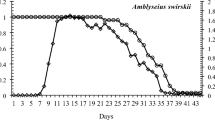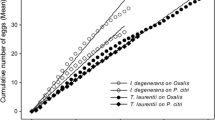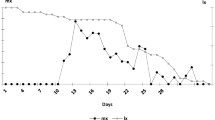Abstract
The influence of four eriophyid mite species as prey, Aceria dioscoridis, Aceria olivi, Aculops lycopersici and Cisaberoptus kenyae, on the biology and demographic parameters of the predatory mite Proprioseiopsis badri, was studied under laboratory conditions. Feeding on A. dioscoridis and A. olivi enhanced the development of P. badri, resulted in the longest mean generation time and were the most suitable foods for the oviposition of the predator, as exhibited by the highest fecundity, net reproductive rate and gross reproductive rate. Preying on A. lycopersici gave the lowest fecundity, net and gross reproductive rates and finite rate of increase; therefore, this prey was the least suitable for the oviposition of P. badri. Preying on A. dioscoridis and A. olivi produced higher intrinsic rates of increase, reproduction rates and finite rates of increase for the predator in comparison with A. lycopersici and C. kenyae, which had the lowest value. These differences in response to various eriophyid pests should be considered for the production of healthy cultures of P. badri.

Similar content being viewed by others
References
Abou-Awad, B. A., El-Sherif, A. A., Hassan, M. F., & Abou-Elela, M. M. (1998). Life history and life table of Amblyseius badryi, as a predator of eriophyid grass mites (Acari: Phytoseiidae: Eriophyidae). Journal of Plant Diseases and Plant Protection, 105, 422–428.
Abou-Awad, B. A., Korayem, A. M., Hassan, M. F., & Abou-Elela, M. A. (2001). Life history of the predatory mite Lasioseius athiasae (Acari: Ascidae) on various kinds of food substances: A polypeptide analysis of prey consideration. Journal of Applied Entomology, 125, 125–130.
Abou-Setta, M. M., Sorrell, R. W., & Childers, C. C. (1986). Life 48: a BASIC Computer program to calculate life table parameters for an insect or mite species. Florida Entomologist, 69, 690–697.
Birch, L. C. (1948). The intrinsic rate of natural increase of an insect population. Journal of Animal Ecology, 17, 15–26.
Castagnoli, M., Simoni, S., & Liguori, M. (2003). Evaluation of Neoseiulus californicus (McGregor) (Acari: Phytoseiidae) as a candidate for the control of Aculops lycopersici (Tryon) (Acari: Eriophyoidea): a preliminary study. Redia, 86, 97–100.
Chatzivasileiadis, E., Boon, J. J., & Sabelis, M. W. (1999). Accumulation and turnover of 2-tridecanone in Tetranychus urticae and its consequences for resistance of wild and cultivated tomatoes. Experimental and Applied Acarology, 23, 1011–1021.
Croft, B. A., & Jung, C. (2001). Phytoseiid dispersal at plant to regional levels: a review with emphasis on management of Neoseiulus fallacis in diverse agro-ecosystems. Experimental and Applied Acarology, 25, 763–784.
Frank, S. D. (2010). Biological control of arthropod pests using banker plant systems: past progress and future directions. Biological Control, 52, 8–16.
Helle, W., & Sabelis, M. W. (1985). Spider mites: their biology, natural enemies and control. Vol.1B. Amsterdam, the Netherlands: Elsevier.
Hessein, N. A., & Perring, T. M. (1986). Feeding habits of the Tydeidae with evidence of Homeopronematus anconai (Acari: Tydeidae) predation on Aculops lycopersici (Acari: Eriophyidae). International Journal of Acarology, 12, 215–221.
Huang, N., Enkegaard, A., Osborne, L. S., Ramakers, P. M. J., Messelink, G. J., Pijnakker, J., et al. (2011). The banker plant method in biological control. Critical Reviews in Plant Sciences, 30, 259–278.
Jung, C., & Croft, B. A. (2001). Aerial dispersal of phytoseiid mites (Acari: Phytoseiidae): estimating falling speed and dispersal distance of adult females. Oikos, 94, 182–190.
Kairo, M. T. K., & Murphy, S. T. (1995). The life history of Rodolia iceryae Janson (Coleoptera: Coccinellidae) and the potential for use in inoculative release against Icerya pattersoni Newstead (Homoptera: Margarodidae) on coffee. Journal of Applied Entomology, 119, 487–491.
Kawai, A., & Mainual Haque, M. (2004). Population dynamics of tomato russet mite, Aculops lycopersici (Massee) and its natural enemy, Homeopronematus anconai (Baker). Japan Agricultural Research Quarterly, 38, 161–166.
Kreiter, S., Tixier, M. S., Croft, B. A., Auger, P., & Barret, D. (2002). Plants and leaf characteristics influencing the predacious mite Kampimodromus aberrans (Acari: Phytoseiidae) in habitats surrounding vineyards. Environmental Entomology, 23, 119–131.
Krips, O. E., Kleijn, P. W., Willems, P. E. L., Gols, G. J. Z., & Dick, M. (1999). Leaf hairs influence searching efficiency and predation rate of the predatory mite Phytoseiulus persimilis (Acari: Phytoseiidae). Experimental and Applied Acarology, 23, 785–802.
Krips, O. E., Witul, A., Willems, P. E. L., & Dick, M. (1998). Intrinsic rate of population increase of the spider mite Tetranychus urticae on the ornamental crop gerbera: intraspecific variation in host plant and herbivore. Entomologia Experimentalis et Applicata, 89, 159–168.
McMurtry, J. A., & Croft, B. A. (1997). Life-styles of phytoseiid mites and their roles in biological control. Annual Review of Entomology, 42, 291–321.
Momen, F. M. (1999). Biological studies of Amblyseius lindquisti, a specific predator of eriophyid mites (Acarina: Phytoseiidae: Eriophyidae). Acta of Phytopathologica et Entomologica Hungarica, 34, 245–251.
Momen, F. M., & Abdel-Khalek, A. (2008). Effect of the tomato rust mite Aculops lycopersici (Acari: Eriophyidae) on the development and reproduction of three predatory phytoseiid mites. International Journal of Tropical Insect Science, 28, 53–57.
Momen, F. M., Abou-Elela, M. M., Metwally, A. M., Nasr, A. K., & Saleh, K. M. (2011). Biology and feeding habits of the predacious mite, Lasioseius lindquisti (Acari: Ascidae) from Egypt. Acta Phytopathologica et Entomologica Hungarica, 46, 151–163.
Momen, F. M., & El-Sawy, S. (1993). Biology and feeding behavior of the predatory mite, Amblyseius swirskii (Acari: Phytoseiidae). Acarologia, 34, 199–204.
Momen, F. M., & Hussein, H. (1999). Relationships between food substance, developmental success and reproduction in Typhlodromus transvaalensis. Acarologia, 40, 107–111.
Momen, F. M., Rasmy, A. H., Zaher, M. A., Nawar, M. S., & Abou-Elella, G. M. (2004). Dietary effect on the development, reproduction and sex-ratio of the predatory mite Amblyseius denmarkeri Zaher & El-Borolossy (Acari: Phytoseiidae). International Journal of Tropical Insect Science, 24, 192–195.
Pratt, P. D., & Croft, B. A. (2000). Banker plants: Evaluation of release strategies for predatory mites. Journal of Environmental Horticulture, 18, 211–217.
Ramakers, P. M. J., & Voet, S. J. P. (1995). Use of castor bean Ricinus communis for the introduction of the thrips predator Amblyseius degenerans on glasshouse-grown sweet pepper. Mededelingen van de Faculteit Landbouwwetenschappen Rijksuniversiteit Gent, 60, 885–891.
Sabelis, M. W. (1991). Life–history evolution of spider mites (pp. 23–49). In: R. Schuster & P. W. Murphy (Eds.) The Acari: Reproduction, development and life-history strategies. London, UK: Chapman & Hall.
Sabelis, M. W., van Baalen, M., Baker, F. M., Bruin, J., Drukker, B., Egas, M., et al. (1999). The evolution of direct and indirect plant defence against herbivorous arthropods (pp. 109–166). In: H. Olff, V. K. Brown, & R. H. Drent (Eds.) Herbivores: Between plants and predators. Oxford, UK: Blackwell.
Scott Brown, A. S., Simmonds, M. S. J., & Blaney, W. M. (1999). Influence of species of host plants on the predation of thrips by Neoseiulus cucumeris, Iphiseius degenerans and Orius laevigatus. Entomologia Experimentalis et Applicata, 92, 283–288.
Skirvin, D. J., & de Courcy Williams, M. (1999). Differential effects of plant species on a mite pest (Tetranychus urticae) and its predator (Phytoseiulus persimilis): implications for biological control. Experimental and Applied Acarology, 23, 497–512.
Skirvin, D., & Fenlon, J. (2001). Plant species modifies the functional response of Phytoseiulus persimilis (Acari: Phytoseiidae) to Tetranychus urticae (Acari: Tetranychidae): implications for biological control. Bulletin of Entomological Research, 91, 61–67.
van Rijn, P. C. J., & Tanigoshi, L. K. (1999a). Pollen as food for the predatory mites Iphiseius degenerans and Neoseiulus cucumeris (Acari: Phytoseiidae): dietary range and life history. Experimental and Applied Acarology, 23, 785–802.
van Rijn, P. C. J., & Tanigoshi, L. K. (1999b). The contribution of extrafloral nectar to the survival and reproduction of the predatory mite Iphiseius degenerans on Ricinus communis. Experimental and Applied Acarology, 23, 281–296.
Xiao, Y., Avery, P., Chen, J., McKenzie, C., & Osborne, L. (2012). Ornamental pepper as banker plants for establishment of Amblyseius swirskii (Acari: Phytoseiidae) for biological control of multiple pests in greenhouse vegetable production. Biological Control, 63, 279–286.
Xiao, Y., Chen, J., Cantliffe, D., McKenzie, C. L., Houben, K., & Osborne, L. (2011). Establishment of papaya banker plant system for parasitoid, Encarsia sophia (Hymenoptera: Aphilidae) against Bemisia tabaci (Hemiptera: Aleyrodidae) in greenhouse tomato production. Biological Control, 58, 239–247.
Zaher, M. A. (1984). Survey and ecological studies on phytophagous, predaceous and soil mites in Egypt. 1. Phytophagous mites in Egypt (Nile Valley and Delta). PL. 480 Programme U.S.A. Project No. EG-ARS-30. Grant No. FG-EG-139.
Author information
Authors and Affiliations
Corresponding author
Additional information
This paper is a part of Ph.D. thesis by the junior author Khaled M. Saleh, that will be submitted to the Department of Agricultural Zoology and Nematology, Faculty of Agriculture, Al-Azhar University.
Rights and permissions
About this article
Cite this article
Momen, F.M., Metwally, AE.M., Nasr, A.E.K. et al. Life history of Proprioseiopsis badri feeding on four eriophyid mite species (Acari: Phytoseiidae and Eriophyidae). Phytoparasitica 42, 23–30 (2014). https://doi.org/10.1007/s12600-013-0333-x
Received:
Accepted:
Published:
Issue Date:
DOI: https://doi.org/10.1007/s12600-013-0333-x




